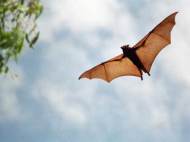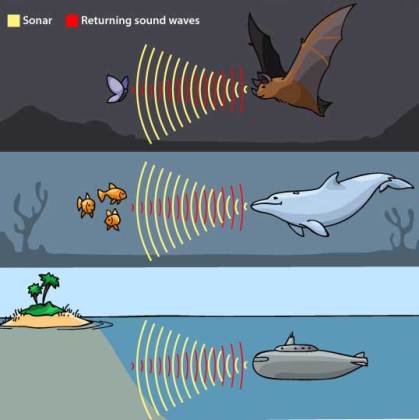Bat biosonar biomimicry for improved sonar technology
 Comparable to some other animals on our planet, bats use other methods instead sight in order to navigate or hunt. They are able to “see” in the dark by sending out sound waves that bounce back to the bats’ ears from objects such as fruit on trees and flying insect prey. The echolocation or biosonar is currently a simpler way for robots to perceive shapes than pattern recognition programs and is much more applicable in areas without the needed light.
Comparable to some other animals on our planet, bats use other methods instead sight in order to navigate or hunt. They are able to “see” in the dark by sending out sound waves that bounce back to the bats’ ears from objects such as fruit on trees and flying insect prey. The echolocation or biosonar is currently a simpler way for robots to perceive shapes than pattern recognition programs and is much more applicable in areas without the needed light.
“We aim to understand the echolocation process that bats have evolved over millennia, and employ similar signals and techniques in engineering systems. We are currently looking to apply these methods to positioning of robotic vehicles, which are used for structural testing. This will provide enhanced information on the robots’ locations, and hence the location of any structural flaws they may detect”, said researcher Simon Whiteley from the Centre for Ultrasonic Engineering at the University of Strathclyde.
Whiteley and his colleagues recorded the echolocation calls of six Egyptian fruit bats that were mounted with miniature wireless microphone sensor. The bats generate these calls with “clicks” from their tongues that fill their surroundings with acoustic energy. The pace of the return of the sound waves sketches the dimensions of the bats’ environment and lets them zip around even when lighting is quite poor.
During echolocation, some bats are known to use a natural acoustic gain control. This allows them to emit high-intensity calls without deafening themselves, and then to hear the weak echoes returning from surrounding objects.
The six bats performed up to sixteen flights each along a flight corridor. Each flight was short (lasting only about three seconds), however, since the bats’ clicks last only a quarter of a millisecond, a large number of calls were recorded for the scientists to analyze. Afterwards, the researchers were able to accurately recreate the echolocation calls in their laboratory by using a custom-built ultrasonic loudspeaker.
The research was conducted as part of a larger program of research known as BIAS (Biologically Inspired Acoustic Systems) that included the Universities of Southampton and Leeds. The team believes the techniques could have a wide range of potential applications, including improving the location-finding abilities of people with hearing aids or cochlear implants, or even making medical ultrasound systems more sensitive and able to pick out different tissue types under the skin or positioning of robotic vehicles used in structural testing applications.










Bat’s Flight has been inspiration for Scientists. Radar is based on the ultrasonic principle of bat.
Dr.A.Jagadeesh Nellore(AP),India
Hi who owns the copyright to the image above.
Thanks
Unless it is stated that we own the rights on some images in our articles, all the images in our articles are either public domain images, or taken from the source linked in the article.
Can i use this picture for a public event?
You can see image ownership once you click on them for enlargement.
this is awesome